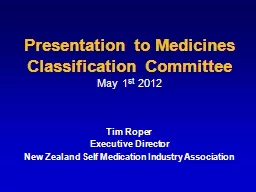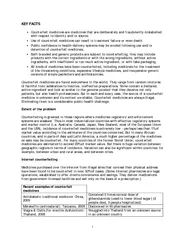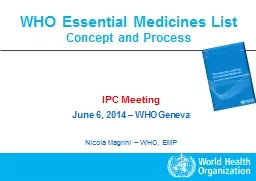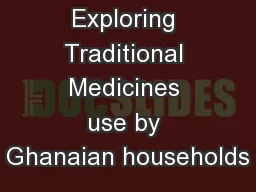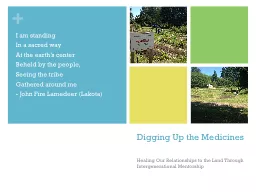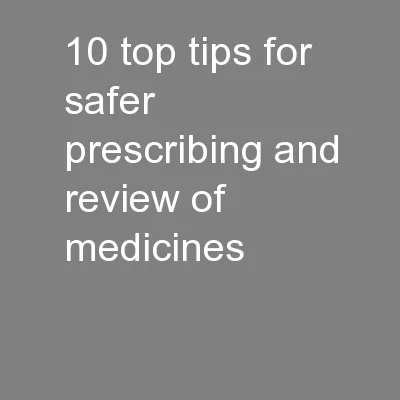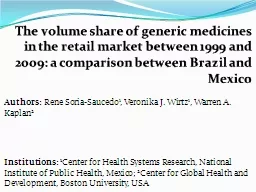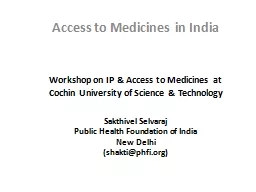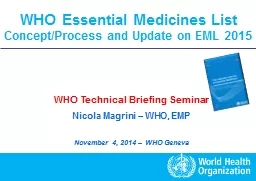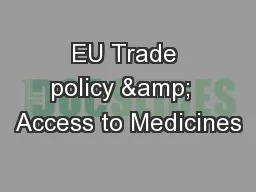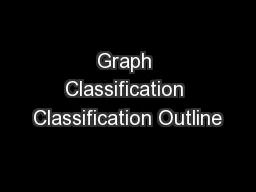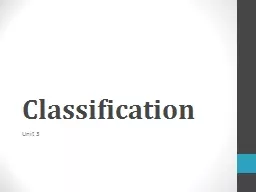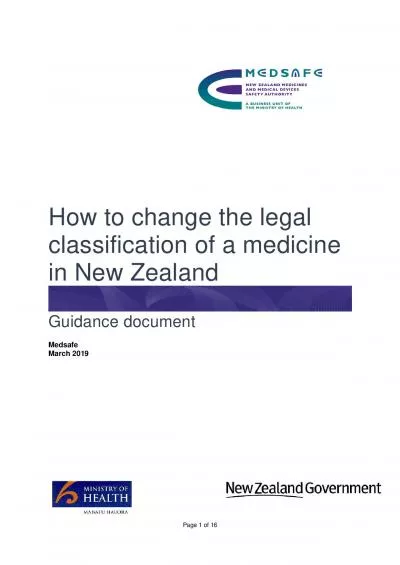PPT-Presentation to Medicines Classification Committee
Author : olivia-moreira | Published Date : 2016-06-28
May 1 st 2012 Tim Roper Executive Director New Zealand Self Medication Industry Association A New Approach to BenefitRisk Assessment for Nonprescription Drugs Eric
Presentation Embed Code
Download Presentation
Download Presentation The PPT/PDF document "Presentation to Medicines Classification..." is the property of its rightful owner. Permission is granted to download and print the materials on this website for personal, non-commercial use only, and to display it on your personal computer provided you do not modify the materials and that you retain all copyright notices contained in the materials. By downloading content from our website, you accept the terms of this agreement.
Presentation to Medicines Classification Committee: Transcript
May 1 st 2012 Tim Roper Executive Director New Zealand Self Medication Industry Association A New Approach to BenefitRisk Assessment for Nonprescription Drugs Eric P Brass MD PhD Professor of Medicine David Geffen School of Medicine at UCLA. Sedative hypnotics depress or slow down the bodys functions These drugs are commonly referred to as tranquilizers sleeping pills or sedatives They were originally developed to treat medical conditions such as epileptic seizures as well as to treat a Use of counterfeit medicines can result in treatment failure or even death Public confidence in healthdelivery syst ems may be eroded following use andor detection of counterfeit medicines Both branded and generic products are subj ect to counterfei Concept and Process. IPC Meeting. June 6, 2014 – WHO Geneva. Nicola Magrini – WHO, EMP. Essential Medicines. Guiding principle:. . A limited range of carefully selected essential medicines leads to better health care, better medicines management, and lower costs. Azusa Sato. London School of Economics, UK. Introduction. Traditional medicines (TM)/healers: WHO. ‘the knowledge, skills and practices based on the theories, beliefs and experiences indigenous to different cultures, used in the maintenance of health and in the prevention, diagnosis, improvement or treatment of physical and mental illness’. Healing Our Relationships to the Land Through Intergenerational Mentorship. I am standing. In a sacred way. At the earth’s center. Beheld by the people,. Seeing the tribe. Gathered around me. - John Fire . Dr Duncan Petty. Lecturer Practitioner. School of Health Care, University of Leeds. RCN Advanced Nurse Practitioner. Forum conference 2011. 10 top tips for safer prescribing and review of medicines. Dr Duncan Petty. retail . market between 1999 and 2009: a comparison between Brazil and Mexico . Authors:. Rene Soria-Saucedo. 1. , Veronika J. Wirtz. 1. , Warren A. Kaplan. 2. Institutions: . 1. Center for Health Systems Research, National Institute of Public Health, Mexico; . Cochin University of Science & Technology . Sakthivel. . Selvaraj. Public Health Foundation of India . New . Delhi . (shakti@phfi.org). Access to Medicines in India . Key Barriers to . Access to Medicines . Concept/Process and Update on EML 2015. WHO Technical Briefing Seminar. Nicola Magrini – WHO, EMP. November 4, 2014 – WHO Geneva. Essential Medicines. Guiding principle:. . A limited range of carefully selected essential medicines leads to better health care, better medicines management, and lower costs. –. lessons from HIV. EPIP, 5 September 2017, Bordeaux. . Ellen ‘t Hoen, LLM. University Medical Centre Groningen, Global Health Unit. @. ellenthoen. www.medicineslawandpolicy.org. Brief history. Stops AIDS National Gathering . 1st November 2014. Aliénor Devali. ère. Health. Action International (HAI) Europe. This document arises from HAI Europe’s Operating Grant 2014, which has received funding from the . Introduction, Overview. Classification using Graphs. Graph classification – Direct Product Kernel. Predictive Toxicology example dataset. Vertex classification – . Laplacian. Kernel. WEBKB example dataset. Please sit down if you:. Are taller than 5’9”. Have blonde Hair . Have brown Eyes. Are left-Handed. Why Classify?. To study the diversity of life, biologists use a . classification . system to name organisms and group them in a logical manner. ��Page of ContentsPurpose and scope................................Definitions................................Background and legislative context.......................Medicines Classific
Download Document
Here is the link to download the presentation.
"Presentation to Medicines Classification Committee"The content belongs to its owner. You may download and print it for personal use, without modification, and keep all copyright notices. By downloading, you agree to these terms.
Related Documents

